Highlights of the 2008 Chino Airshow
|
As
usual, the 2008 Chino airshow had plenty of sunshine, but an added bonus
this year was the presence of clear blue skies, in contrast to the drab
grey that sometimes afflicts this site in the eastern Los Angeles basin.
Here we see "23 Skidoo", the P-38J Lightning which is based at the Chino
Planes of Fame museum, which organizes the show.
|
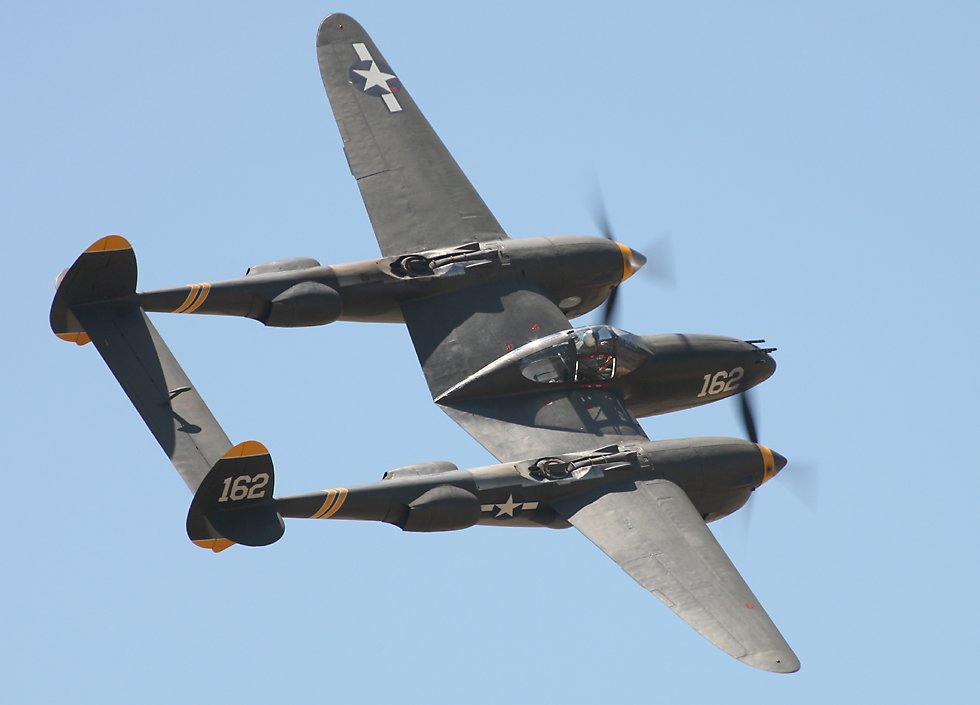 |

|
The
P-38 is a fairly rare warbird type, but this year's show had both 23 Skidoo
and this beautiful 1944 P-38L, which originally operated as a photo reconnaisance
aircraft. This configuration possibly saved it from being scrapped,
because after the war it was bought and operated by a string of civilian
aerial photography companies, before being passed down a long line from
one owner to another, finally ending with Vintage Fighters LLC based in
California.
|
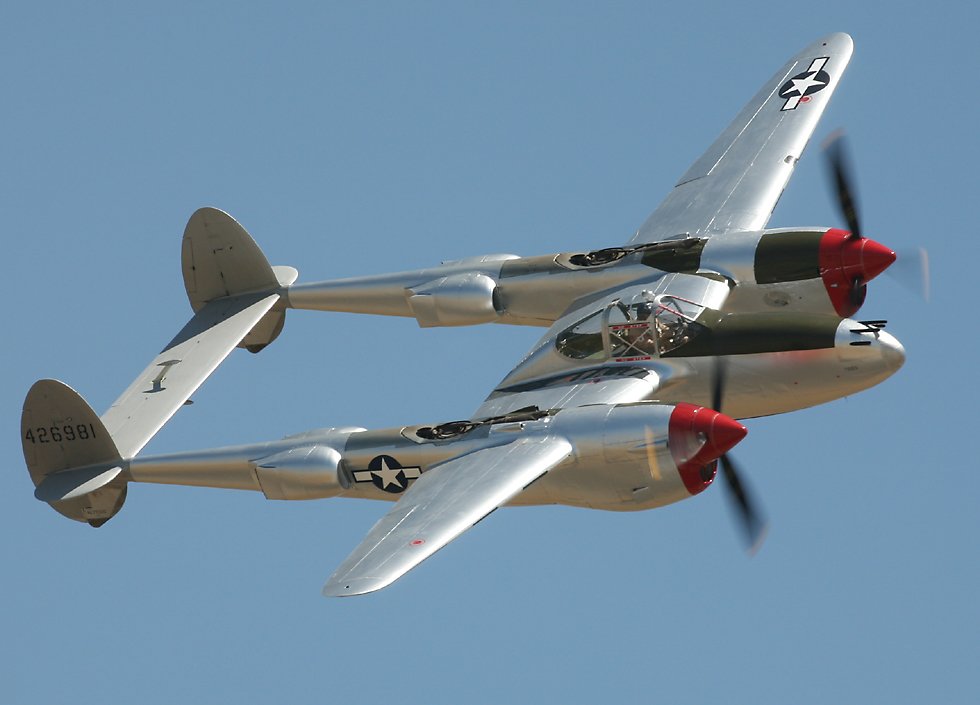 |

|
The
show was a little smaller than usual, probably because of the huge increase
in gasoline prices over the previous 12 months. However since
this is one of the world's largest warbirds shows, there was still a lot
to see, including another pair of world war two fighters, this time P-40
Warhawks. They're a bit more common than P-38s, but it's still
very unusual to see two in formation like this.
|
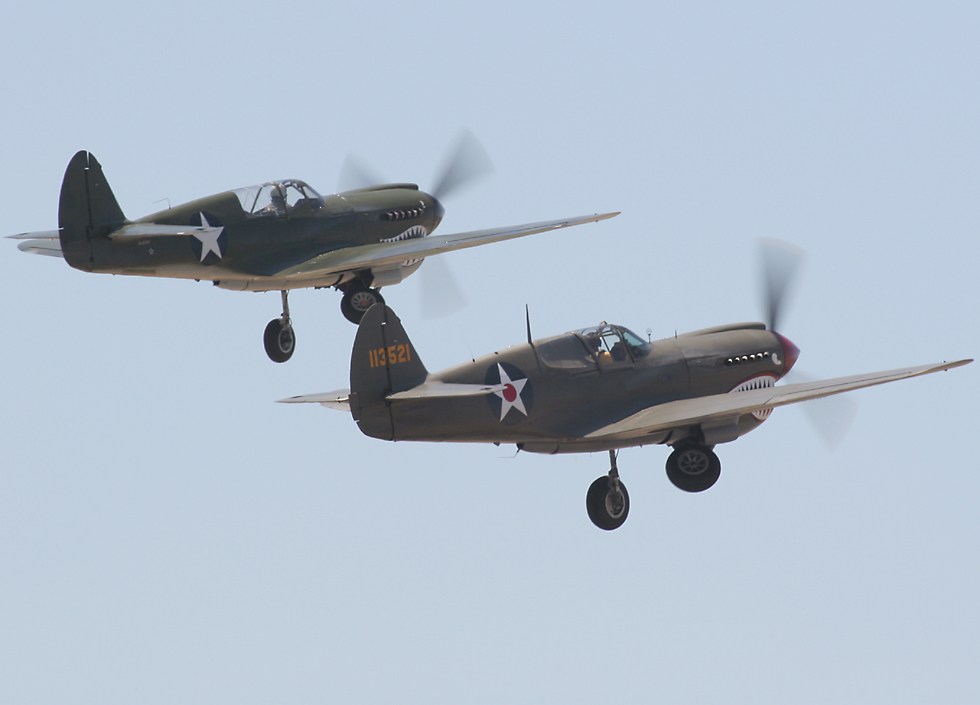
|

|
The
Warhawk was America's first high performance fighter, fairly well armed
and the first to break the 300 mile per hour mark, but by the time America
entered the war it was outclassed in Europe by German fighters like the
Bf 109 and the Fw 190. However it still performed worthwhile
service with American forces, most famously with the Flying Tigers
in China, as well as with other allies like Australia and New Zealand
in the deserts of North Africa.
|
 |

|
The
Planes of Fame museum also owns this rare early "razorback" model of the
P-47G Thunderbolt fighter called "Spirit of Atlantic City NJ".
Later models had a cut-down fuselage behind the pilot which allowed the
fitting of a "teardrop" canopy, which greatly improved visibility to the
rear.
|
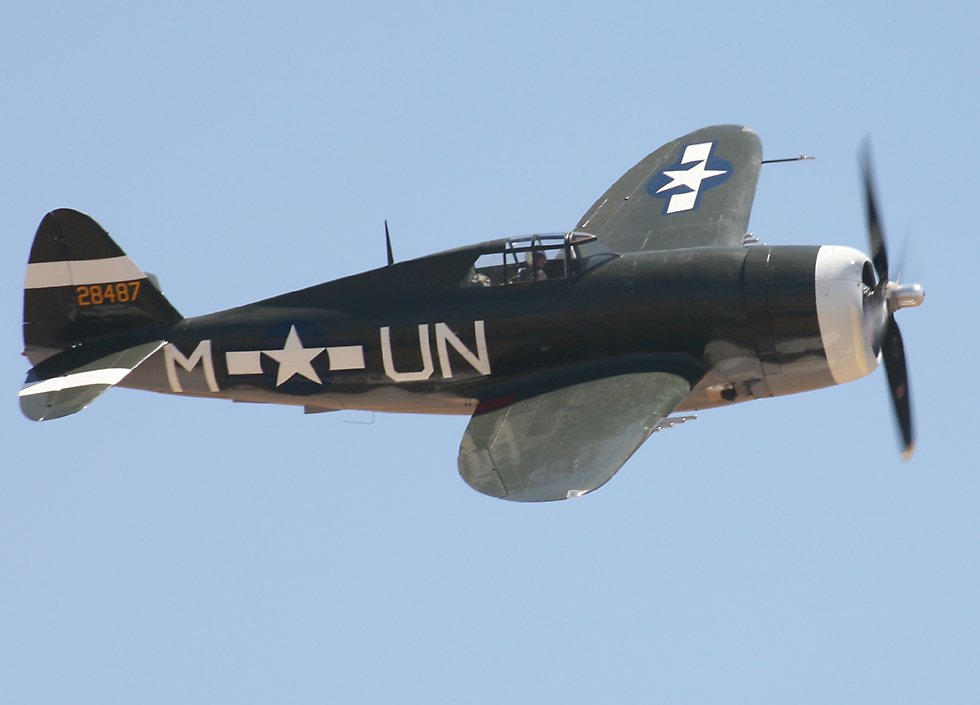 |

|
There
was quite a collection of P-51 Mustangs at the show, including no fewer
than seven in the air and a rare P-51H on static display. But
it was this equally rare early model P-51A which caught my eye.
I saw this same aircraft fly at
the
2002 Duxford "Flying Legends" airshow in the UK, when it was configured
as an A-36 Invader, the dive-bomber version of the Mustang.
|
 |

|
Jim
Beasley and Ed Shipley bill themselves as "The Horsemen" and they performed
a very good aerobatic display on their Mustang mounts "Spam Can" and "Wee
Willy II".
|
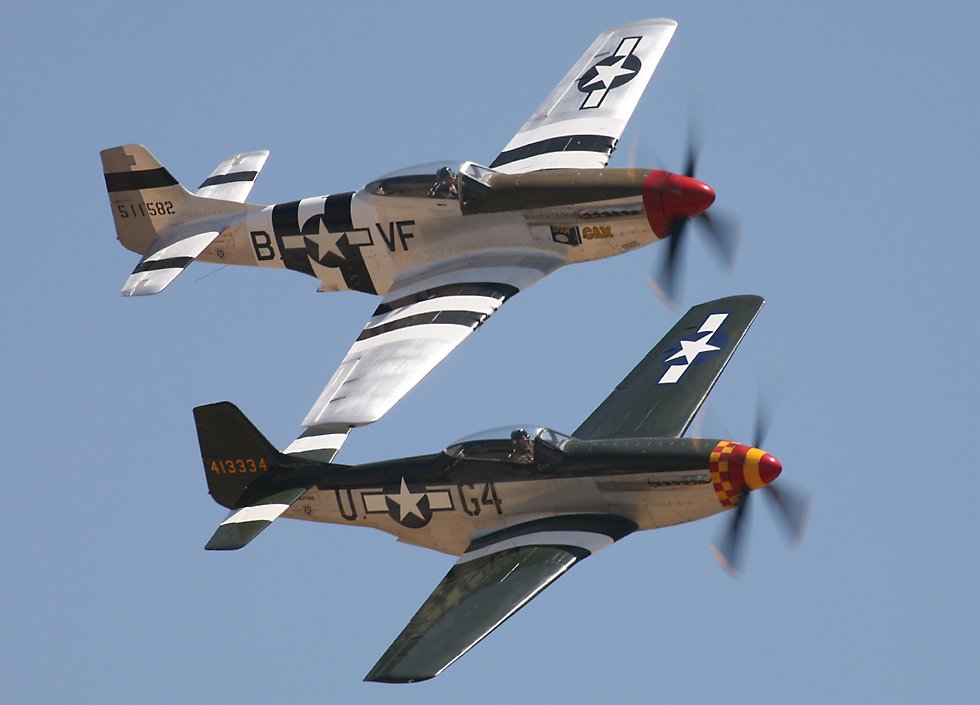
|

|
The
B-17 Flying Fortress "Fuddy Duddy" put on a great show, repeatedly barrelling
around the corner past the appreciative crowd. It's now set
up as a B-17G, but in the 1960s it was flown in the movie "The War Lover"
as a B-17F, and it also appeared in "Tora, Tora, Tora". Fuddy
Duddy used to be based in New York state, but since 2006 it's been operated
in California, a welcome addition to the local warbird scene.
|
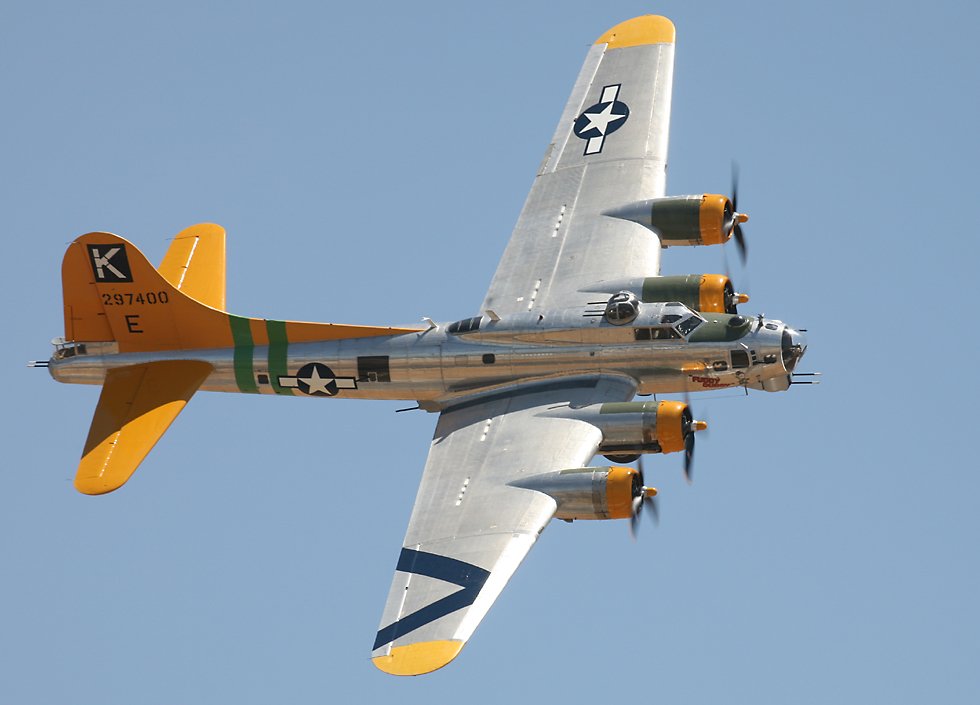 |

|
There
were two B-25 Mitchells flying at the show, including this B-25J, Chino's
own "Photo Fanny".
|
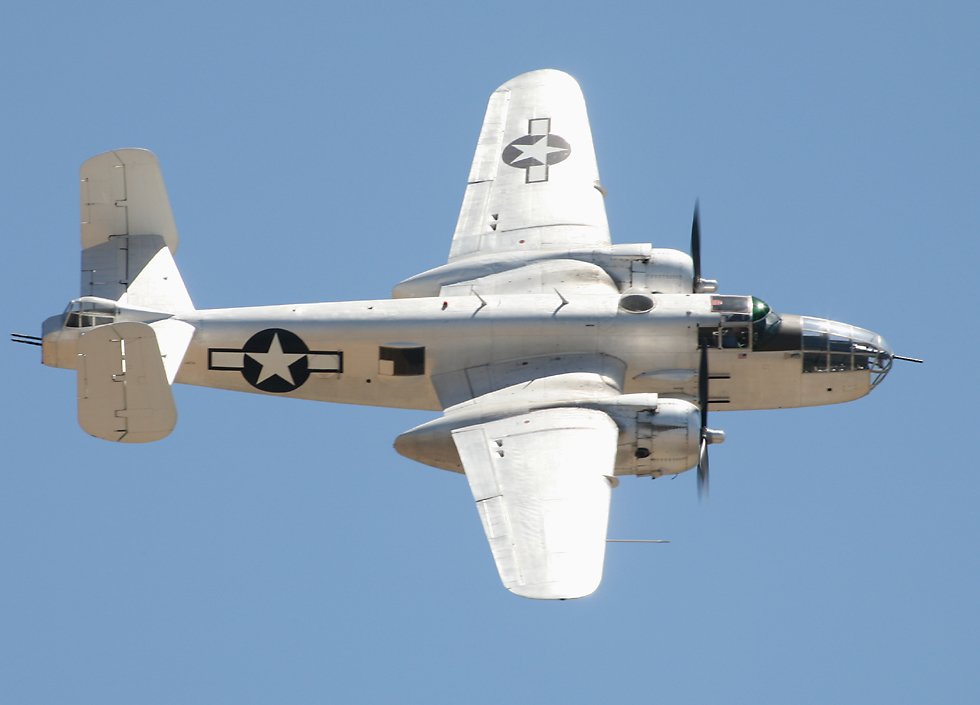 |

|
The
B-17's performance was spectacular in itself, but Fuddy Duddy went on to
provide one of the highlights of the show by flying in formation with Photo
Fanny, a formation I haven't seen at any of the other 50 or shows I've
attended in the USA.
|
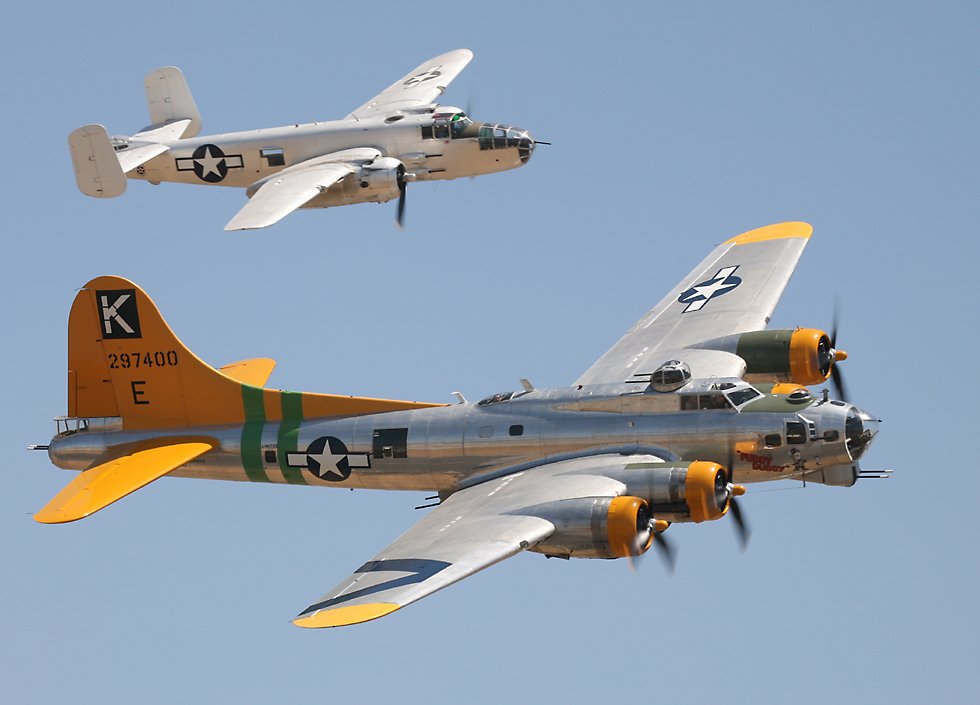
|

|
And
a somewhat looser formation with a "little friend", as the American bomber
crews called their fighter escorts.
|
 |

|
In
addition to all of these air force types, there were also plenty of naval
aircraft, like this Grumman F3F fighter, a type nicknamed The Flying Barrel
because of its rotund fuselage. It was the American navy's
last biplane fighter, serving in the front line from 1937 until the end
of 1941, at which point they were relegated to training and utility work.
Armament was fairly poor, consisting of two machine guns mounted in the
nose cowling, one of 0.30 inch caliber and the other of 0.50 inch.
|
 |

|
The
Grumman F4F Wildcat was originally intended as a biplane successor to the
F3F, but after the design was beaten out by the Brewster Buffalo, the Wildcat
was reconfigured as a monoplane. Still, the similarity with
the F3F is clear, particularly in the design of the cockpit and the recessed
wheels, which in the Wildcat were still manually cranked up and down.
With four 0.50 caliber machine guns, the F4F had a lot more firepower than
the F3F, and a British Royal Navy F4F became the first American-designed
plane to shoot down an enemy aircraft in the European theater, when it
destroyed a Ju 88 bomber over Scapa Flow naval base on Christmas Day, 1940.
|
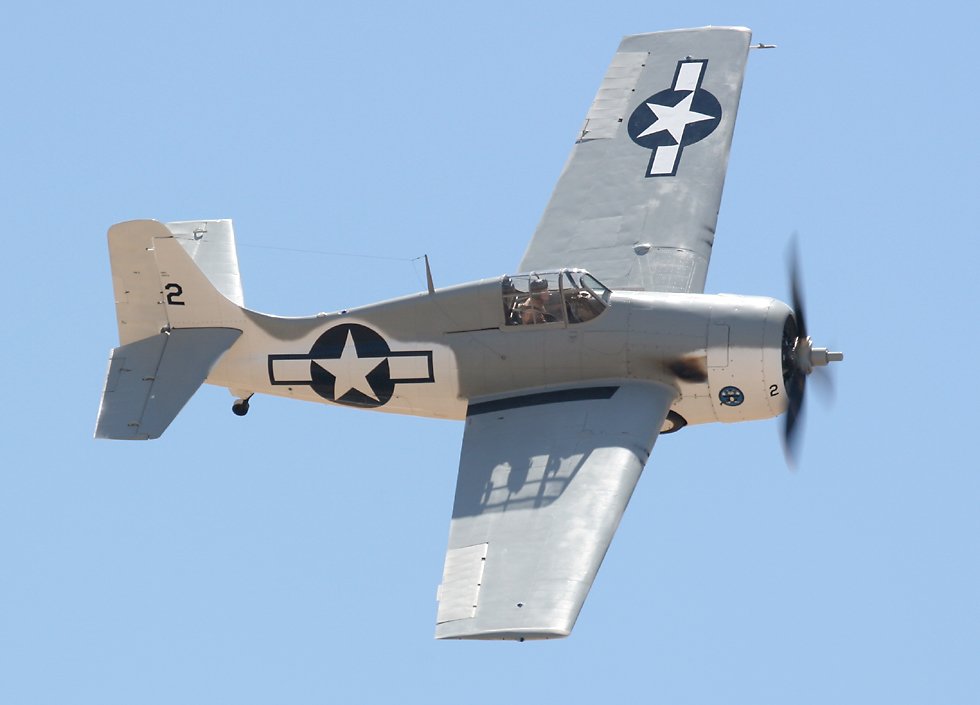 |

|
The
Wildcat was a tough bird, but it had a hard time when up against the nimbler
Japanese Zero fighter, so Grumman developed a faster and more maneuverable
successor called the F6F Hellcat. There aren't too many Hellcats
left, but this immaculate example is operated by the Commemorative Air
Force in Camarillo, not too far northwest of Chino. It's painted
in the color scheme of "Minsi III", the aircraft flown by top navy ace
David McCampbell, who won the Congressional Medal of Honor and shot down
34 Japanese aircraft, including 9 in one morning!
|
 |

|
As
a response to Japanese kamikaze attacks, Grumman developed the F8F Bearcat
as a lightweight fighter able to climb quickly to meet incoming enemy aircraft.
However the dropping of the two atomic bombs on Japan meant that the war
was over before the Bearcat could enter service, and it only earned its
stripes many years later when the French used it during their Indo-China
war. A few modified survivors continue to perform to this day
in a very different role, racing around the pylons at the Reno Air Races.
|
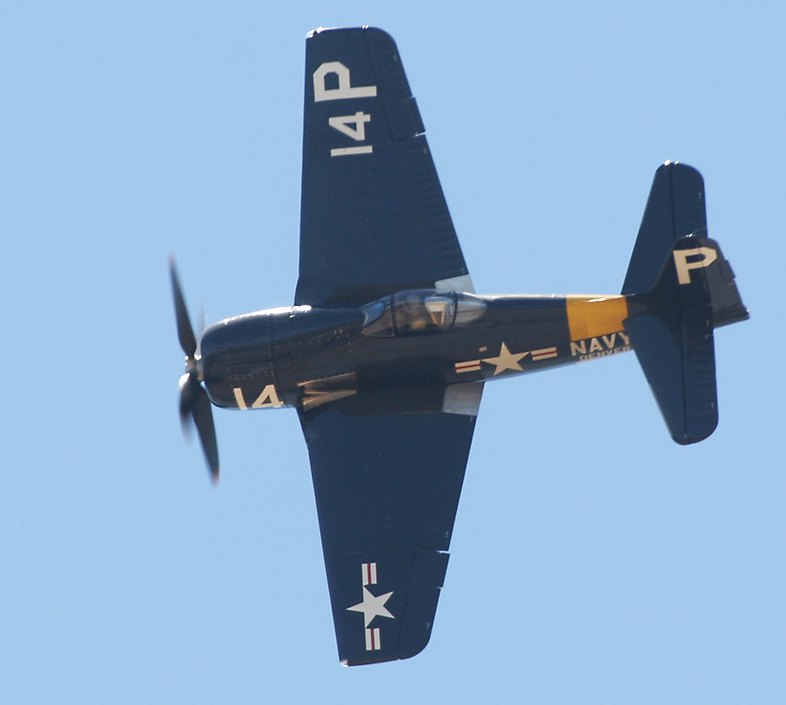 |

|
Another
aircraft which saw extensive service in Indo-China was the Chance-Vought
F4U Corsair, however unlike the Bearcat it came along early enough to see
extensive action in world war two, after certain operational difficulties
were resolved. Although powered by the same Pratt and Whitney
R-2800 Double Wasp engine as the Hellcat, the Corsair's distinctive gull-wing
provided enough ground clearance for a significantly larger 13 foot diameter
propeller with four blades, which made this the navy's first plane able
to break 400mph.
|
 |

|
The
2008 show had no fewer than four Corsairs in the air, through I was only
able to get decent shots of three at a time.
|
 |

|
This
particular Douglas Dauntless dive bomber is of special interest to me,
since it served during world war two with the Royal New Zealand Air Force,
before being returned to the USA in 1944 for use as a trainer.
It took part in various post-war movies, but mostly as a wind machine without
its wings! However it did also do cockpit scenes for the movie
"Midway".
|
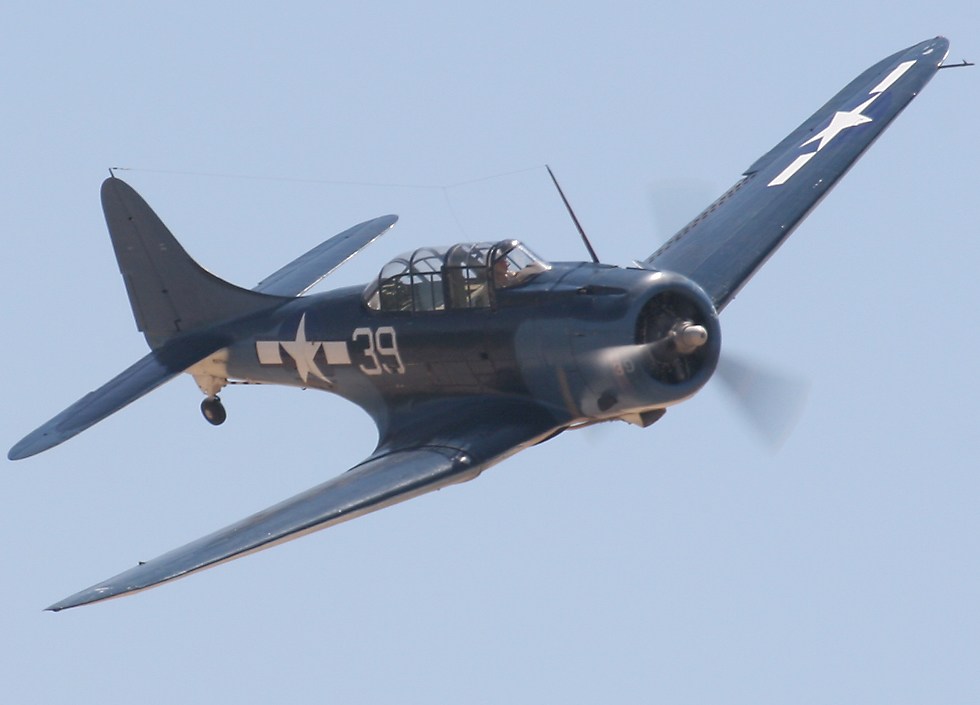 |

|
The
show also featured a good selection of foreign warbirds, which is not common
at an American show. This is a Mk XIV Spitfire delivered in
March of 1945 and sent to Bombay, India, where it served in the Royal Air
Force until it was sold to the Indian Air Force in 1947. The
Far Eastern markings have no red circle in them, so that there would be
no danger of any trigger-happy Allied gunners mistaking the plane for a
Japanese fighter! The bulges over the engine indicate that
it's powered by a Rolls-Royce Griffon engine, the successor to the legendary
Merlin engine. The Griffon has a larger capacity, over 36 liters,
but it's just about the same external size as its predecessor. It
also has some innovative design features such as oil galleries incorporated
into the engine castings, making them more reliable and less vulnerable
to battle damage than the external oil lines used on other engines of the
time. However, the propeller turned in the opposite direction
of the Merlin, requiring opposite rudder on takeoff, a difference that
resulted in numerous crashes both during the war and later, as
noted New Zealand warbird enthusiast learned to his regret.
|
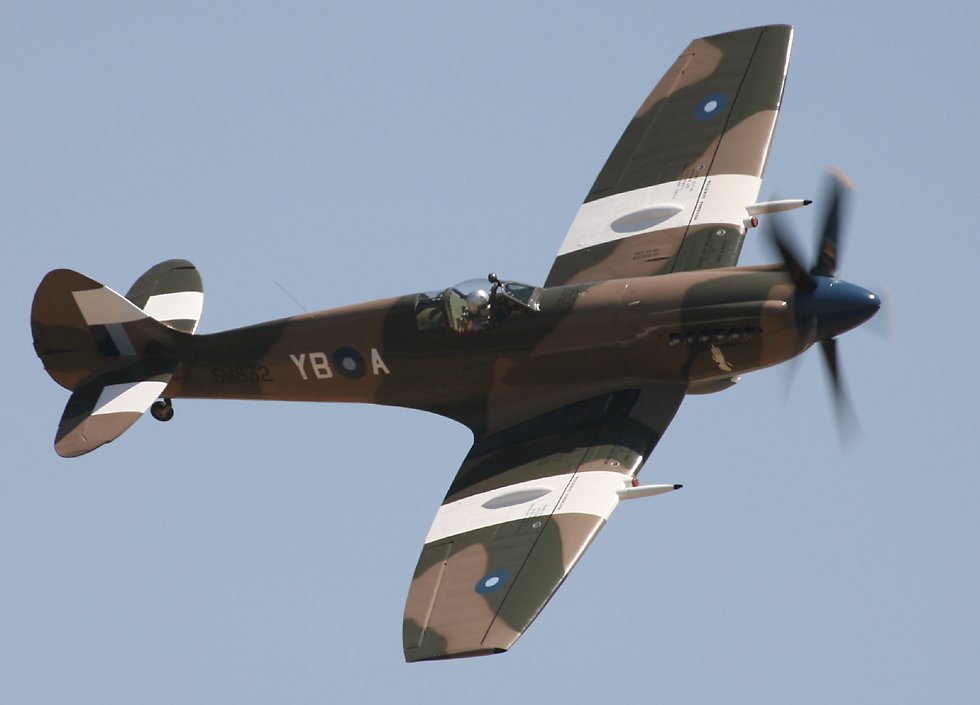 |

|
The
Griffon was originally developed for naval aircraft like this Fairey Firefly,
the torque being intended to take the aircraft away from the superstructure
on takeoff, rather than towards it. Previously operated by
the Royal Australian Navy, this is the only flying Firefly left in the
world, and is displayed very effectively by its owner, Eddie Kurdziel,
who previously flew rather more modern aircraft for the US navy!
The original Griffon II developed 1730 horsepower, and eventually the Griffon
101 generated 2420 horsepower, but with its second crew member and numerous
high-lift devices, the Firefly was never going to be the fastest fighter
in operation, though it was one of the more maneuverable. It
was also armed with cannon rather than the machine guns of equivalent American
aircraft, giving it much greater firepower.
|
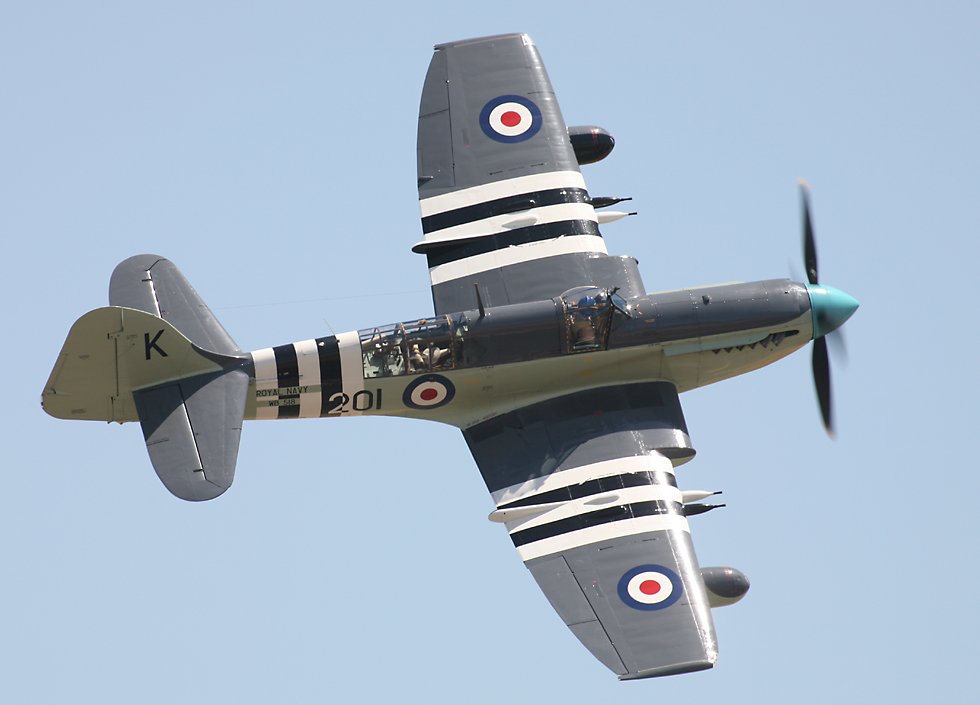
|

|
Brian
Sanders did every bit as good a job as Eddie, flying the beautiful British-designed
Sea Fury "Argonaut" painted in a Canadian navy scheme. He did
several sweeping low-level banked passes as well as his trademark aerobatic
routine complete with smoke from the wingtip canisters. The
Firefly might be slow, but the Sea Fury was a real speedster, inspired
in part by the design of the Focke-Wulf FW 190 fighter, with a very clean
aerodynamic shape and powerful radial engine. Original Sea
Furies used a Bristol Centaurus engine driving a five bladed propeller
(you
can see one of these at the 2007 Nellis AFB "Aviation Nation" airshow).
|
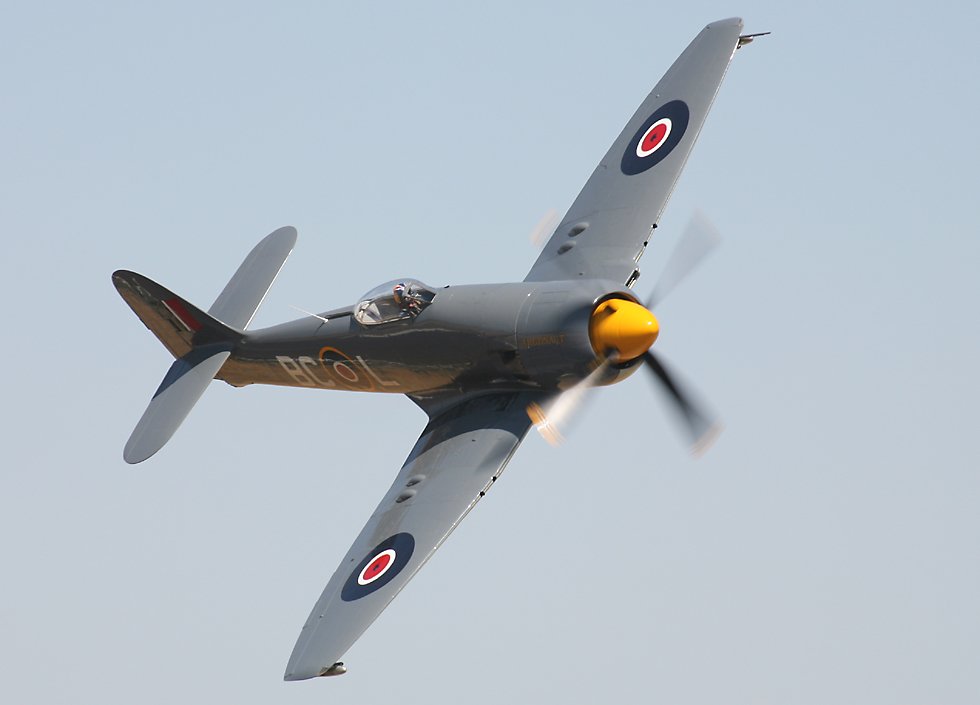
|

|
This
is a replica Aichi Val dive bomber, a type used during Japan's attack on
Pearl Harbor, built from a Vultee BT-15 trainer, a re-engined version of
the
BT-13 Valiant. The Valiant was modified to look like a
Val with a longer fuselage, different cockpit and spatted undercarriage;
it was built for the movie "Tora, Tora, Tora", and later used on the "Pearl
Harbor" movie. It's a very appropriate participant in this
year's show, which had the theme "Wings of the Silver Screen".
|
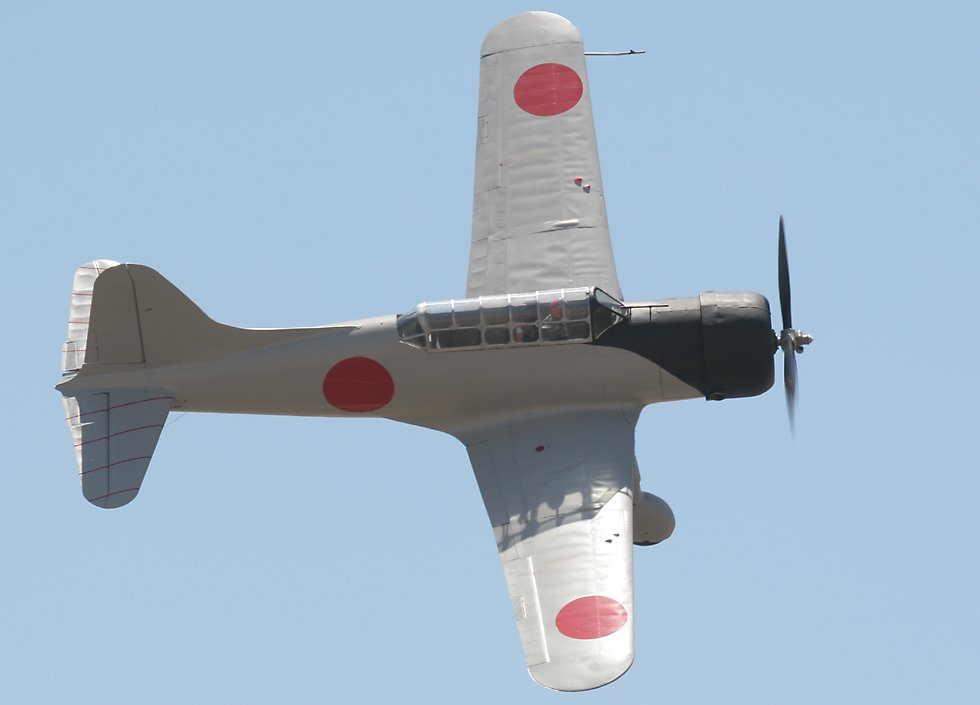 |

|
Both
the Camarillo and Chino Zero fighters flew during the show, but the Chino
example shown here is of much more interest to me, since it's far more
authentic than the other, which has only a few original parts.
In contrast, the Chino A6M5 Zero still has its Japanese Sakae engine from
when it was captured on Saipan in June of 1944. Shortly afterwards
it was taken to the naval test station at Patuxent River, where it was
flown for some time by various pilots, including Charles Lindbergh, in
order to determine its flight characteristics and weaknesses.
|
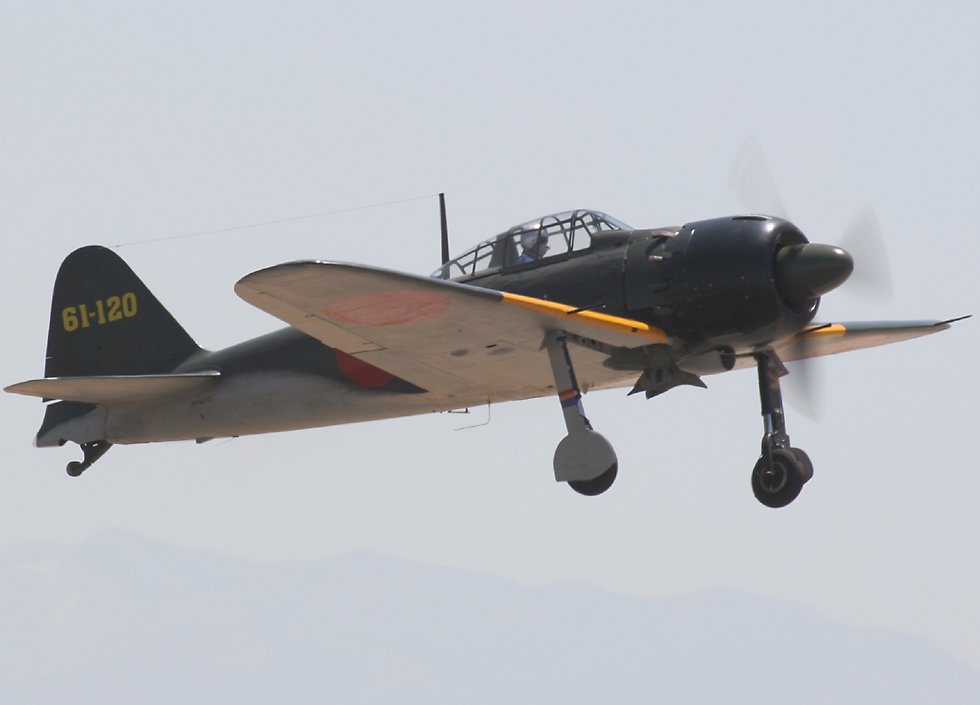
|

|
Chino
always brings in at least one modern military jet to do a display, this
year the honors being done by this F-16 Fighting Falcon from Hill air force
base, seen here doing a fast afterburner pass.
|
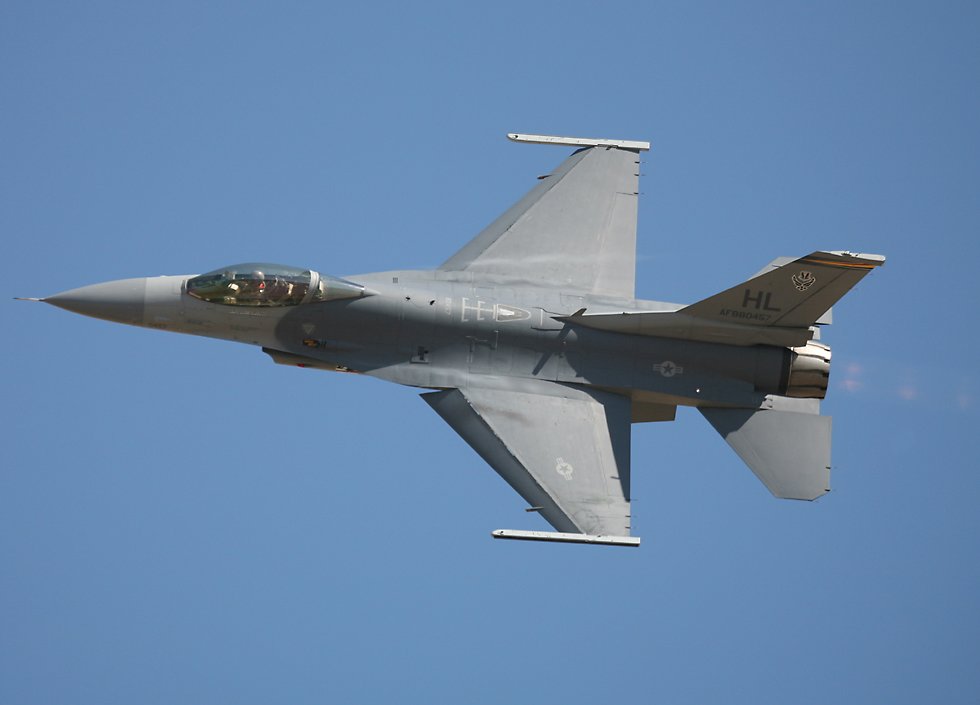 |

|
The
F-16 also did a very effective "Heritage Flight" display with "23 Skidoo"
and "Wee Willy II", showing off the best of old and new air force technology.
|
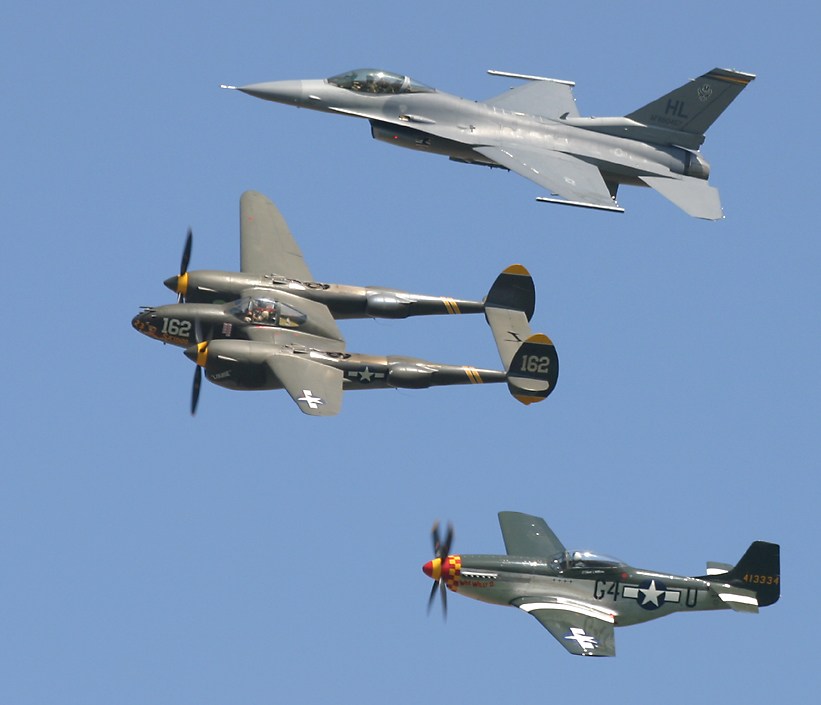
|

|
The
F-16 wasn't the only jet at the show - this MiG-15 "Fagot" was Russia's
premier fighter during the Korean war, outperforming the western allies'
piston-engined fighters and straight-winged P-80 Shooting Star jet.
The MiG-15 carried a very heavy punch, with a very high caliber 40mm cannon
visible under the nose in this photo, and another 23mm cannon on the other
side. This particular aircraft was flown by the Peoples' Liberation
Army of China, before ending up in American hands.
|
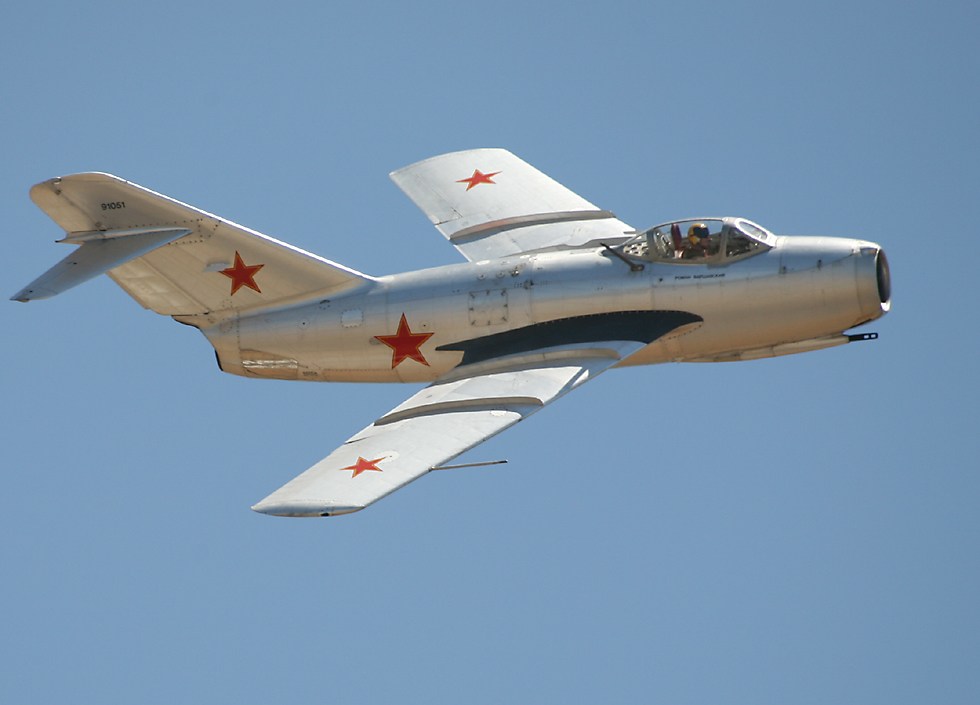 |

|
The
F-86 Sabre was America's answer to the MiG-15. Although more
lightly armed, with six .50 caliber machine guns on the nose, the aircraft
were basically equal in aerodynamic performance and the superior American
training led to a very high kill ratio in favor of the Sabre.
|
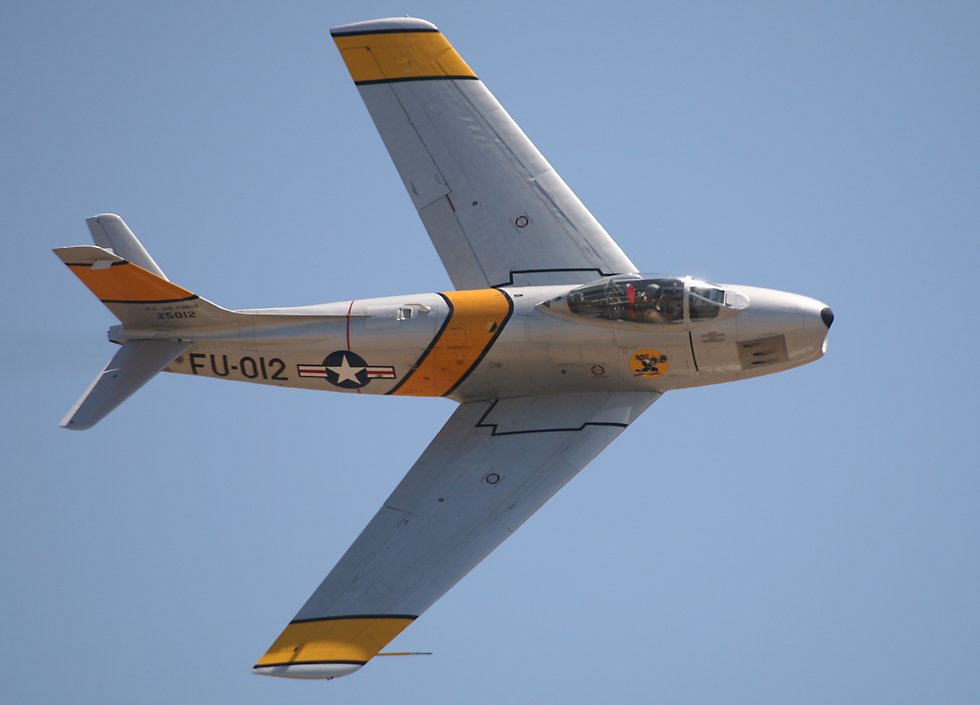 |

|
This
F-86 and MiG-15 are no strangers to the movies, they were used as recently
as this year in the movie "Iron Man". If you don't remember
them in that movie, it's probably because they were standing in for the
two F-22 Raptors which chase Iron Man through the air at high speed.
Using real aircraft gave realistic models for the computer generated Raptors.
|
 |

|
Strega
is a highly modified P-51D Mustang which originally flew with the Royal
Australian Air Force. It now flies in the unlimited class at
the Reno air races, and during the Chino show it had none other than Steve
Hinton's son Steven at the controls. Strega flew together with
another Reno racer, the Sea Fury Mk 20 trainer "Dreadnought", which served
for a time with the Burmese air force.
|
 |

|
The
sky might have been blue, but the heat was intense. Someone
measured the temperature as 114 degrees Fahrenheit (46 degrees celcius)
and my Canon 20D camera died, forcing me to use my backup 5D and 10D.
However it didn't stop the performance by the "Silver Wings" of Hartley
Folstad and his wing-walker Margi Stivers.
|
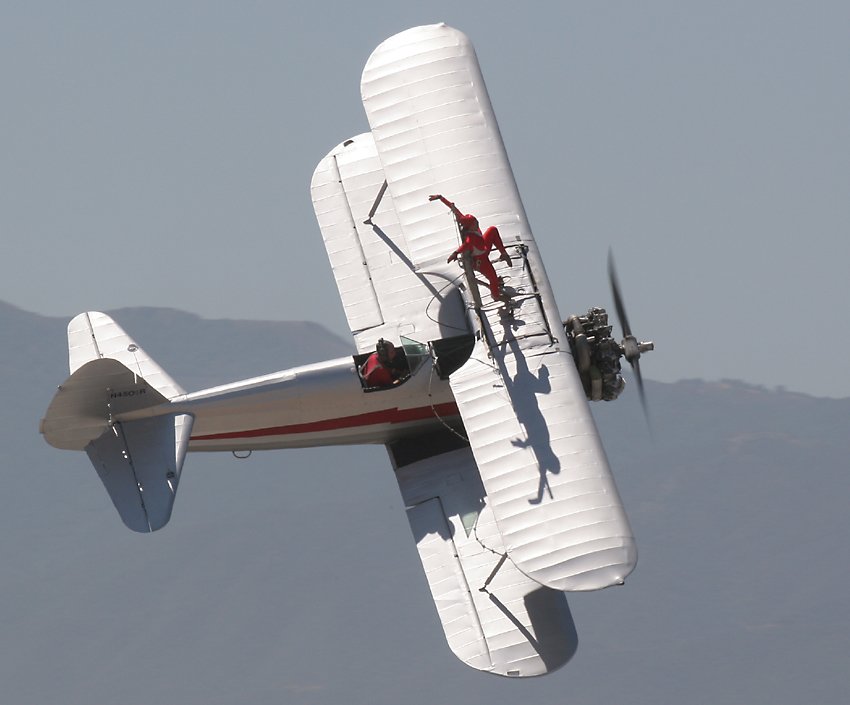
|





























